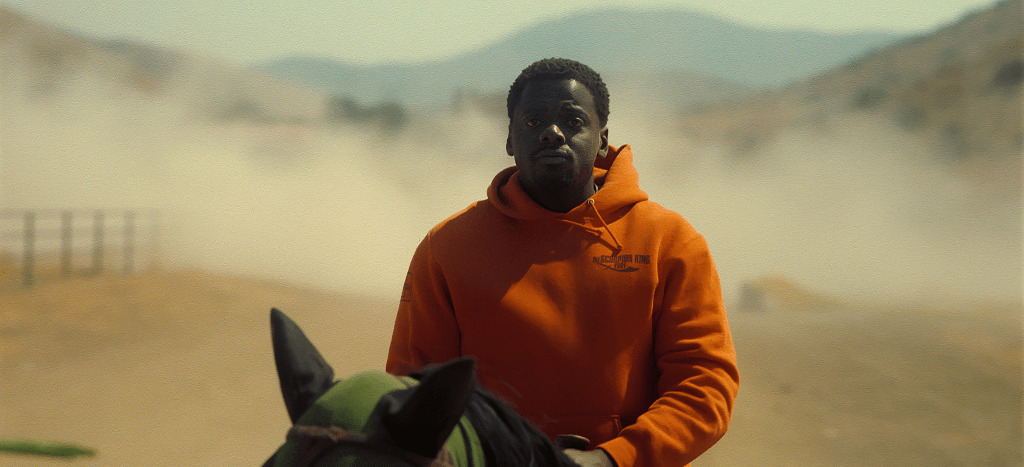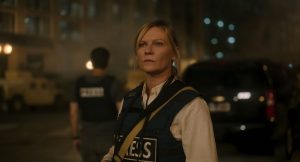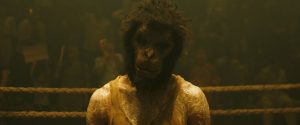Reviews include Irena’s Vow, The Beast, and Before I Change My Mind.
TFCA Friday: Week of July 22
July 22, 2022

Welcome to TFCA Friday, a weekly round-up of film reviews and articles by TFCA members.
In Release this Week
Aftershock (dir. Paula Eiselt and Tonya Lewis Lee)
“Aftershock admittedly loses focus as it tries to account for myriad threads. There’s a lot going on here,” writes Pat Mullen at POV Magazine. “However, COVID-19, George Floyd, and the Black Lives Matter movement deal with many of the same beasts and the ongoing undervaluing of Black lives. The filmmakers’ therefore faced the double-edged sword of lessening Aftershock’s relevance through omission. Including the wider conversations about Black life and systemic racism re-ignited in 2020 was the right decision. What’s lost in finesse is gained in fire.”
Alone Together (dir. Katie Holmes)
“[N]othing really exciting or fresh,” sighs Gilbert Seah at Afro Toronto.
Come Back Anytime (dir. John Daschbach)
“The film is an intimate portrait of one man’s passion for life and his delicious bowls of hot soup noodles and chasu that grew a community,” writes Rachel Ho at POV Magazine. Ho chats with director John Daschbach to learn how he created an atmosphere was warm as a bowl of ramen. “Especially since you can’t taste it, I didn’t want to obsess about the food,” Daschbach tells Ho. “You have to show the food, and you have to explain why it’s important. But ultimately, that’s not what feels so great there. It’s him and the community. That’s what we really focused on and built towards in the structure. It starts on a superficial level, and as the film goes on, you get to know everyone on a deeper level. It starts with what do you think of the soup and then by the end, it’s [about] who the Master is to you personally.”
“What about the food? Come Back Anytime is a wonderful food film,” noodles Marc Glassman at Classical FM. “Even if you don’t love ramen, the noodles that form the base of soup, you won’t fail to be impressed by the elements that make Masamato’s recipe so appealing: a mixture of pork, chicken, soy, bamboo shoots, noodles, tofu and vegetables that becomes overwhelmingly appealing. Some call the homey intense and loving formula to be the equivalent of North America’s chicken noodle soup.”
“Maybe I’ve had my fill of Japanese food docs,” munches Chris Knight at the National Post. “The excellent Jiro Dreams of Sushi. The so-so Sushi: The Global Catch. Ramen Shop. Ramen Heads. This newest, Come Back Anytime, is lovely as far as it goes, but it feels like a dish I’ve had before.”
Fire of Love (dir. Sara Dosa)
“Their deaths were perhaps inevitable — Maurice, a fatalist, spoke of their ‘kamikaze existence in the beauty of volcanic things’ — but their lives were not without purpose,” writes Peter Howell at the Toronto Star. “Their research led to timely warnings about eruptions that helped save thousands of people. Sara Dosa’s unique documentary refuses to wallow in tragedy. Instead, it commits to a mad embrace of destiny, with eye-searing archival footage and an appreciation of the ineffability of devotion.”
“In the poetic and playful documentary Fire of Love, director Sara Dosa takes a look at [the Kraffts’] life together, their passion for volcanoes and their legacy,” observes Karen Gordon at Original Cin. “Dosa has also chosen to keep the tone playful. Maurice and Katia did the thing they loved, making their own rules, seemingly very bonded. There are not a lot of images of them together, but what we see is two people having fun. Playful, sometimes flirtatious, often both together, each of them absorbed in whatever task was in front of them.”
“Adopting an aesthetic that I can only approximate as Wes Anderson lite, the filmmaker isn’t so much interested in telling us about the Kraffts or even about the little-understood science of volcanology (you might walk out of here knowing less about volcanoes than you did walking in), but in creating a low-key twee mood that edges past cute straight into grating,” says Barry Hertz at The Globe and Mail.
“[C]ontains some of the most stunning images of volcanoes and volcanic activity ever captured on film,” observes Gilbert Seah at Afro Toronto.
“What makes Fire of Love such an astounding film is its ability to be a lot of things at once effectively,” notes Rachel Ho at Exclaim!. “It’s the perfect marriage between education, philosophy, sensory engagement and human connection. And in that way, Fire of Love is also the perfect tribute to two extraordinary souls and their love for one another.”
“It can’t be overemphasised how majestic some of the footage is, too. While hardly diving deep into the science of volcanology, Fire of Love doesn’t shy away from diving into some of the more esoteric elements of the discipline,” writes Jason Gorber at POV Magazine. Gorber also situates Fire of Love within a recent crop of archival documentaries that engage with the four elements and the thrill of discovery: “Sunshine Superman, Fire of Love, Becoming Cousteau, and Jane: four archival docs about pioneering individuals who used film to tell their stories to the world; four films that show the limits of human experience, but also our shared connections to their passion for the wonders of the world we inhabit,” writes Gorber. “Each documentary explores a different facet of the drive to explore the limits of experience, whether it is through earth, fire, water, or air. Perhaps it is our shared humanity that is the most elemental aspect of all of these films.”
“Dosa walks a fine line with her subjects. While their work was undoubtedly dangerous, and while Maurice had a penchant for stunts – he once paddled across a lake of sulfuric acid in an inflatable raft, and had an unfulfilled dream of riding a space-age fireproof canoe down a river of lava – they were also careful and conscientious,” writes Chris Knight at the National Post. “Seeing the devastation caused by volcanoes drove them to learn how to predict them, though sadly we’re not there yet.”
“The two admit to a kind of addiction to volcanos and live on them, away from people, at one with one of the earth’s most powerful forces,” notes Anne Brodie at What She Said. “They say a volcano gives hints when it’s about to blow – it shudders, smells putrid and the skies shift. Thanks to their footage are fortunate to see sights few people in the world get to, and survive.”
“The most extraordinary element in Fire of Love is the footage of the volcanoes. The shots are literally to-die-for: the Kraffts took crazy risks to get photos and film shoots that no one else would try to make. It made their books and docs so worthwhile, and, in death, it has made this film into something truly unique,” says Marc Glassman at Classical FM. “As a doc habitué, I have attended over 500 pitch sessions in which filmmakers try to sell their projects to seasoned commissioning editors. At Hot Docs, I attended the session for Fire of Love, which included a short sizzle reel of Krafft volcano footage plus the story of their doomed love. It is in my top five of best pitches I’ve ever seen as Sara Dosa’s team skillfully persuaded a panel of veteran professionals to back the film.”
“This film is for anyone buoyed by life’s big questions, yet driven by the magnetic pull of romance,” raves Pat Mullen at POV Magazine. Mullen also chats with director Sara Dosa about telling the love story of Maurice and Katia Krafft, volcanoes, and harnessing their sense of wonder: “One of the greatest lessons from their work is what it means to capture something you love through images,” says Dosa. “How powerful that can be when your own emotions, even if they might seem invisible, can be detected. That’s something I will always take with me on every project moving forward: the fuel, the power, the force that that love has. They taught me how meaningful it is to tell stories where you’re guided by that love.”
Glasshouse (dir. Kelsey Egan)
“Drama. Glasshouse does not lack in it,” admits Thom Ernst at Original Cin. “Egan’s refusal to bend to genre conventions can be refreshing, but only after processing the disappointment that follows from the intensity of the opening scenes. The story veers away from science-fiction and into melodrama—a chamber room apocalypse done with grace and decency as if to say, “The ruin of humankind is a poor excuse for bad manners.” Egan allows the drama to undercut the intensity she establishes in the film’s opening scenes.”
Moloch (dir. Nico van der Brink)
At Afro Toronto, Gilbert Seah notes, “an effectively scary horror film is aided by solid night cinematography with its setting of images of the setting of peat bog’s murky waters.”
Nope (dir. Jordan Peele)
“Kaluuya turns in another world-class performance as OJ. It’s rare to see such a subtle performance in a loud, spectacle-driven movie. The strong and silent rancher shuffles about like the world’s weight rests on his shoulders. He may not have lots to say, but OJs every glance speaks volumes,” writes Victor Stiff at Victor Stiff Reviews. “Palmer matches Kaluuya’s movie star charisma beat for beat. Em is not one to bite her tongue, so her larger-than-life personality is matched only by her colourful outfits. She’s loud, blunt yin to her brother’s soft-spoken yang.”
“[V]eteran Canadian actor Michael Wincott has his own scene-stealing moments as a movie director who sees an opportunity for filmmaking glory, shooting the power-dampening mystery object with an ancient hand-cranked camera,” notes Jim Slotek at Original Cin. “Of the three horror films Peele has made (including Get Out and Us), Nope is arguably the third best. But that isn’t a particularly damning assessment. All three are worth the watch, and Peele has already effectively sold me a ticket to his next movie.”
“Peele’s exceptional script and direction, the story’s density, intelligence, and thrilling creativity are so strong the experience becomes visceral,” writes Anne Brodie at What She Said. “The climate, invasion, and bad miracles may keep us up at night because it’s strong stuff – hardcore brainy, poetic trauma horror / old-fashioned spectacle that also manages to address social and cultural issues.”
“The Gordy part of Nope is so compelling, it threatens to overwhelm that UFO saga, which meanders more than it motors as it heads toward a blockbuster finale that takes full advantage of the IMAX lensing by cinematographer Hoyte van Hoytema (Dunkirk, Tenet),” observes Peter Howell at the Toronto Star. “Peele lards in the characters of a goofy tech salesman (Brandon Perea) and a grizzled cinematographer (Michael Wincott, conjuring the ghost of Robert Shaw from Jaws).”
“Nope is a confusing and tedious [and] often incomprehensible and irrational sprawling mess of a slow burn horror movie despite Peele’s visionary ideas,” says Gilbert Seah at Afro Toronto. “Whether to see the new horror entertainer from Jordan Peel? NOPE! But the Peele brand is sufficient to drag many, myself included, to see this piece.”
“[W]hile Nope is pushing its shot-for-Imax format, I was most impressed with the sound design,” writes Chris Knight at the National Post. “There are moments where we hear things long before we see them, and the sound alone is enough to dig into whatever primitive part of your brain it is that raises your hackles. Like this summer’s Top Gun: Maverick, this is a film for the big screen, but equally for the invisible Dolby-enhanced sound system.”
This Is Gwar (dir. Scott Barber)
“A doc is often as interesting as its subject,” notes Gilbert Seah at Afro Toronto. “One cannot argue that Gwar is never interesting or controversial. The film’s best moments are the archive footage of the band in performance on stage, screaming their songs, while battling on stage and at the same time spraying the spectators with simulation of body fluids.”
On the Toronto Film Beat
Barry Hertz at The Globe and Mail speaks with maxine bailey upon the one-year anniversary of her post as the new executive director of the Canadian Film Centre, who reveals some field-levelling changes: fees are freezing. “It’s one thing to say you’re open and invite everybody to the party, but if people can’t afford it or are stressing out about bills while trying to be creative, it’s not helpful,” bailey tells Hertz. “Sometimes these things that seem so hard or big, it’s just a matter of going to new people and saying, ‘Here’s our new story. Are you in for the ride?’ It’s amazing what happens when you just ask people.”
All eyes are on TIFF’s slow trickle of release announcements, so Pat Mullen at That Shelf offers a TIFF wish list of ten films he hopes to see get the eyeball emoji treatment from the festival. Atop the list? Earth Camp One from director Jennie Livingston: “It’s been 32 years since Jennie Livingston’s debut film Paris Is Burning played the Festival of Festivals. It went on to win top honours at Sundance and Berlin, and remains one of the most influential American documentaries of all time. However, Livingston hasn’t made a feature doc since then,” writes Mullen. “Livingston’s sophomore documentary, Earth Camp One, also accounts for her absence quite poignantly. The film is a personal study of heartache years in the making, as Livingston lost five close family members in one decade. The doc frames her essay within a larger consideration of impermanence.”
TV Talk/Series Scribbles
At What She Said, Anne Brodie has fun with Ethan Hawkes’ doc series about Paul Newman and Joanne Woodward, The Last Movie Stars: “While the doc looks at their burdens and tragedies…it is a hagiography. Hey, I don’t mind – it’s great fun with insight into how a man as famous as Newman handled his life.” Plus: here comes Shark Week! “Jaws made it ok for us to demonize them, but they have their place in nature, and they aren’t normally threats,” writes Brodie.
At Exclaim!, Marriska Fernandes chats with Umbrella Academy’s Jake Epstein about the third season of Netflix’s hit series, working with Eliot Page, and having fun under gobs of make-up: “[Y]ou put on the face, and the suit and something happens to you; you start walking in a different way,” says Epstein. “And it kind of gives you license to start improvising and having a lot of fun. Alphonso is kind of the big weirdo of the family. So I really took that role on with pride and had a lot of fun on set.”
At NOW, Radheyan Simonpillai chats with Rap Sh!t creators Issa Rae, Syreeta Singleton, Aida Osman, and KaMillion about their new series and the parallels for women in the male-dominated fields of music and television. “Women are using their voices more to say this is our bodies, this is what we will do or won’t do with our bodies and we should have the right,” says Singleton. “All of these things are parallel, when it comes to the art that we make, how we choose to express ourselves, what we choose to wear and our right to choose. They’re all relevant in so many different ways. So it makes sense that it will show up in our music too.”



